To efficiently migrate volunteers from another database, use the import tool.
You can bulk import all your data, including custom fields. Profiles import as well, which means your volunteers don’t have to reenter profile information. You can use an import to create new accounts, update existing accounts, or both.
To help you with this process, Bloomerang Volunteer:
- Generates an optional import template that you can download
- Guides you through the import
In this article:
- Before You Begin
- Download the Import Template
- Export Your Data
- Import Your Data
- View the Import History
- Resolve Errors
- Invite Volunteers
Before You Begin
Before you import, set up and customize Bloomerang Volunteer. For example, set up your custom questions, roles, qualifications, tag data, and other information before you import. These data types automatically appear as columns in the import template.
Tip: To add custom fields, add custom questions. Clear the Enable checkbox for a question to make sure it doesn't appear on the registration form.
Download the Import Template
After you customize Bloomerang Volunteer, download the import template. The template is a comma-separated values (CSV) file.
The columns included in the import template depend on where you download the template. You can download the template from these locations:
- Organization level — If you plan to import users into your organization but not into an opportunity
- Opportunity level — If you plan to import users into a specific opportunity
To download the import template:
- Open your organization or the opportunity.
- Click Staff.
- From the Staff drop-down list, select Import from .CSV.
- Click Download Template.
A file named staffList.csv downloads to your computer.
Export Your Data
In the database you’re migrating from, export your data.
Keep in mind these requirements:
- The file type must be .CSV.
- You can import up to 15,000 users (rows) at a time, which means the file must contain 15,000 or fewer rows. If you have more users, split the import into separate .CSV files.
- The .CSV file must include these required columns: First Name, Last Name, and Email.
- Certain fields must be written correctly. For example, multi-select responses must be comma separated and match answer options that exist in Bloomerang Volunteer.
- Duplicate or empty column headers are not allowed.
Import Your Data
First, decide where to run the import:
- Organization level — To import users into your organization but not into an opportunity
- Opportunity level — To import users into a specific opportunity. Whether users also import to your entire organization depends on your recruitment settings. If you turn on Automatic Approval, users import to your opportunity. If you turn on Manual Approval, users appear in the Pending Applications list.
Note: The import cannot run if the file is not a .CSV file, includes more than 15,000 users (rows), or has duplicate column headings.
Next, follow these steps:
- Step 1: Upload the Import File
- Step 2: Import Your Parameters
- Step 3: Map Your Data
- Step 4: Review Data Mappings
- Run the Import
Step 1: Upload the Import File
To import volunteers:
- Open the organization or opportunity.
- Click Volunteers.
- From the Volunteer list, select Import from .CSV.
The Import Users wizard opens. - Click Choose a .CSV File to Upload. Or, drag and drop your .CSV here.
- Click Next Step.
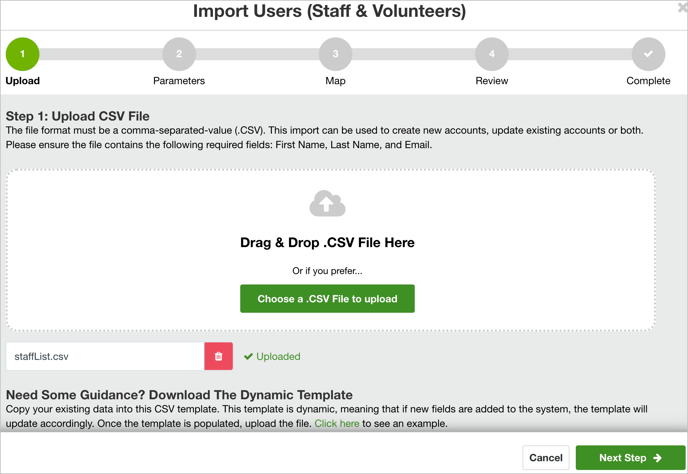
Step 2: Import Your Parameters
Next, set the import parameters:
- Select the Default Date Format used in the database you’re migrating from.
- Select what you want the import to do:
- Update & Create — Update existing users. Create new users, who will have unclaimed accounts.
- Create Only — Create new users, who will have unclaimed accounts. Do not update existing users.
- Update Only — Update existing users. Do not create new users.
Tip: Use this option make bulk changes to question response or other data.
- Select Consent to GDPR Data Privacy Guidelines to agree that all users have given their consent for you to import their personal data.
- Select whether you want to send a welcome email. This setting appears only if the import wizard detects you have an existing Welcome Email Automation.
- Click Next Step.
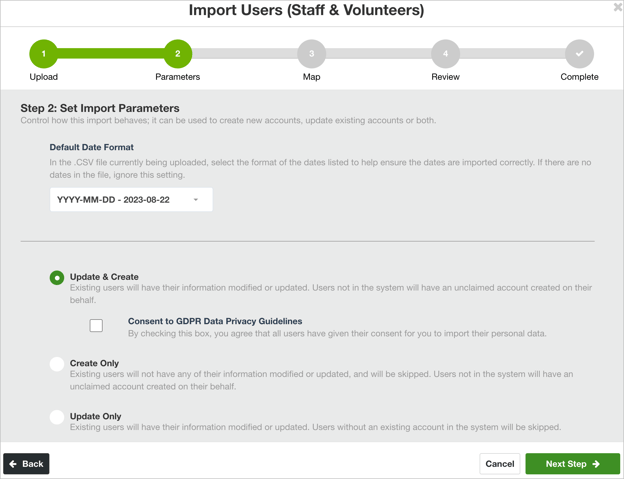
Step 3: Map Your Data
Next, map your data. When you map data, you match fields in your import file to fields in Bloomerang Volunteer.
To make the import easier for you, fields map automatically in some cases. Fields with identical names automatically map, regardless of capitalization. Fields with common alternative names automatically map. For example, Phone maps automatically to Phone Number, E-mail maps to Email, and Shirt maps to T-Shirt Size.
You can also manually map fields. You do not have to rename fields to exactly match Bloomerang Volunteer fields.
The Imported Fields list shows the fields in your .CSV import file. The Mapped Fields list shows the fields in your .CSV import file.
To map your data:
- Make sure each row in the Imported Fields list maps to the correct row in the Mapped Fields list. You can select a different field from a drop-down list.
- To manually map fields, select or search for an option from the Imported Fields list. You must map required fields. You cannot map the same field twice.
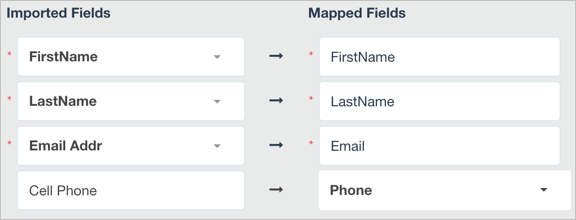
- To exclude a field from the import, don’t map it. You can also leave the field empty.
- Click Next Step.
- If you don’t map a field, select whether to continue. Bloomerang Volunteer warns you about unmapped fields.
Step 4: Review Data Mappings
Before you complete the import, review the import sample. The sample includes the first fifteen rows to be imported. To make changes, click Back.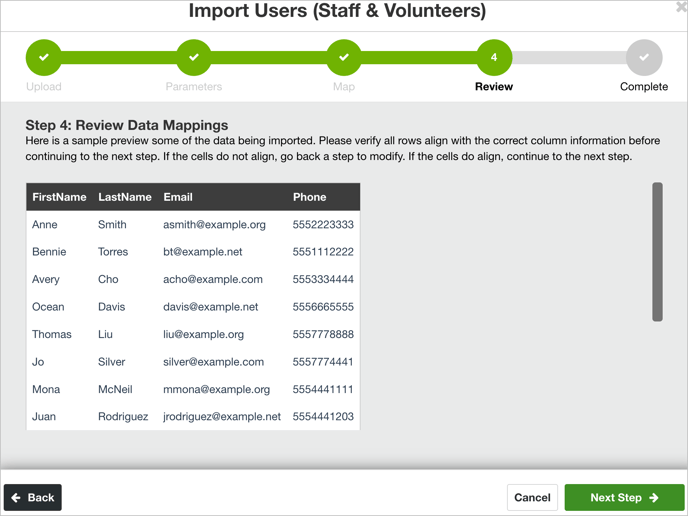
Run the Import
To run the import, click Next Step. The import starts immediately.
After the import completes, Bloomerang Volunteer emails you a confirmation.
View the Import History
You can view a list of every import. For each import, you can see these details:
- Status: A blue icon
 indicates the import is in progress
indicates the import is in progress - Import type: Volunteers
- Import location: Organization-level import
 or an opportunity-level import
or an opportunity-level import 
- Date and time
- Who ran the import
- Number of rows imported
- Number of accounts created, updated, and ignored
- Number of cells with errors
To review the import history:
- Open the opportunity.
- Click Reports & Imports.
- Click Imports.
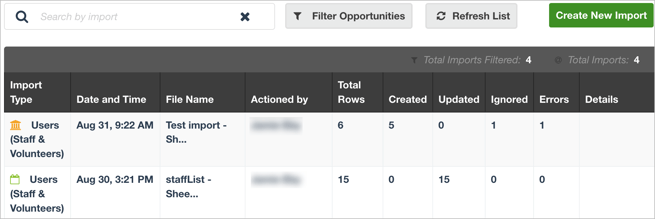
- To see more information about an import, hover over the row and click Details.
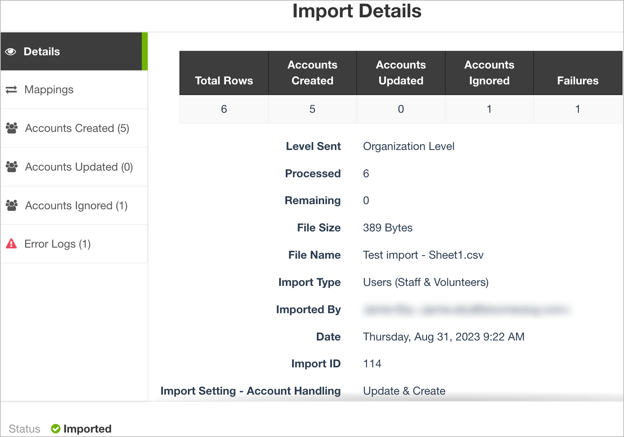
Resolve Errors
The import excludes rows in your .CSV file when:
- First name or last name is empty
- Duplicate email addresses exist in the import file
- Bio exceeds 40,000 characters
- Address line exceeds 100 characters
- Date format is missing or incorrect
- Data isn’t entered correctly, such as an invalid email address or country, or multi-select responses that aren’t comma separated or don’t match answer options in Bloomerang Volunteer
- Address includes a state or province, but not a country
To resolve errors for rows that didn’t import:
- Open the opportunity.
- Click Reports & Imports.
- Click Imports.
- Click Error Logs.
- Click Download Error File. This file includes only rows with errors.
A file named error_logs.csv downloads to your computer.
- In the error_logs.csv file, edit each row to resolve the issue.
- Import the error_logs.csv file.
Invite Volunteers
After you import, send an invite to volunteers to invite them to Bloomerang Volunteer. You can help them join the organization or an opportunity. From the invitation email, users can claim their account, set a password, and sign up.
If you have a Welcome Automation set up, Bloomerang Volunteer automatically sends the welcome email.
If you enable the Form Questions setting in the recruitment settings for the opportunity, all the information that you imported appears in the form question answers. Volunteers can change their answers if needed. If you enable the Roles setting for the opportunity, roles and qualifications that you imported are preselected.
If you already screened volunteers, and you don’t want users to adjust any settings, turn off all of the signup steps that ask users to enter information. On the shift selection page, volunteers see only the shifts they are qualified for, based on the information that you imported.
